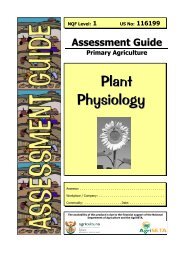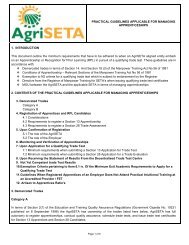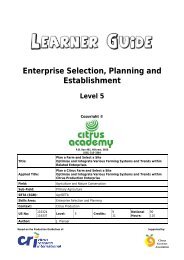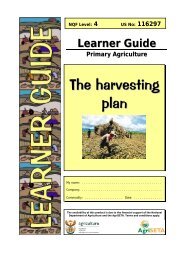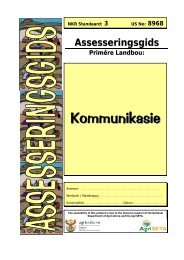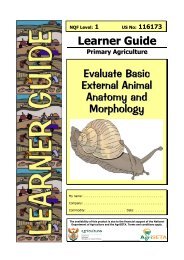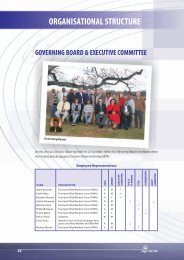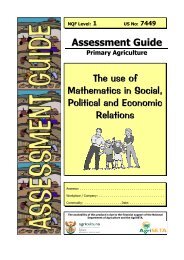Explore & Use a Variety of Strategies to Learn - AgriSETA
Explore & Use a Variety of Strategies to Learn - AgriSETA
Explore & Use a Variety of Strategies to Learn - AgriSETA
You also want an ePaper? Increase the reach of your titles
YUMPU automatically turns print PDFs into web optimized ePapers that Google loves.
<strong>Explore</strong> and use a variety <strong>of</strong> strategies <strong>to</strong> learn (revised)Primary Agriculture NQF Level 1 Unit Standard No: 1247152.2Instructions <strong>to</strong> <strong>Learn</strong>er:The facilita<strong>to</strong>r will read you a set <strong>of</strong> instructions. Follow themexactly and draw the picture.SO 2 AC 1 - 7<strong>Learn</strong>er Workbook: Page 7 Facilita<strong>to</strong>r Guide: Page 11- 12Model answers:Assess learner’s ability <strong>to</strong> draw picture on instructions given by an outsider.My Notes …. . . . . . . . . . . . . . . . . . . . . . . . . . . . . . . . . . . . . . . . . . . . . . . . . . . . . . . . . . . . . . . . . . . . . . . . . . . . . . . . . . .. . . . . . . . . . . . . . . . . . . . . . . . . . . . . . . . . . . . . . . . . . . . . . . . . . . . . . . . . . . . . . . . . . . . . . . . . . . . . . . . . . .. . . . . . . . . . . . . . . . . . . . . . . . . . . . . . . . . . . . . . . . . . . . . . . . . . . . . . . . . . . . . . . . . . . . . . . . . . . . . . . . . . .. . . . . . . . . . . . . . . . . . . . . . . . . . . . . . . . . . . . . . . . . . . . . . . . . . . . . . . . . . . . . . . . . . . . . . . . . . . . . . . . . . .. . . . . . . . . . . . . . . . . . . . . . . . . . . . . . . . . . . . . . . . . . . . . . . . . . . . . . . . . . . . . . . . . . . . . . . . . . . . . . . . . . .2.3Instructions <strong>to</strong> <strong>Learn</strong>er:Try the following exercise <strong>to</strong> assess your own skills.SO 2 AC 1 - 7<strong>Learn</strong>er Workbook: Page 8 Facilita<strong>to</strong>r Guide: Page 11- 12Model answers:Assess learner’s ability <strong>to</strong> do a self-assessment.My Notes …. . . . . . . . . . . . . . . . . . . . . . . . . . . . . . . . . . . . . . . . . . . . . . . . . . . . . . . . . . . . . . . . . . . . . . . . . . . . . . . . . . .. . . . . . . . . . . . . . . . . . . . . . . . . . . . . . . . . . . . . . . . . . . . . . . . . . . . . . . . . . . . . . . . . . . . . . . . . . . . . . . . . . .. . . . . . . . . . . . . . . . . . . . . . . . . . . . . . . . . . . . . . . . . . . . . . . . . . . . . . . . . . . . . . . . . . . . . . . . . . . . . . . . . . .. . . . . . . . . . . . . . . . . . . . . . . . . . . . . . . . . . . . . . . . . . . . . . . . . . . . . . . . . . . . . . . . . . . . . . . . . . . . . . . . . . .. . . . . . . . . . . . . . . . . . . . . . . . . . . . . . . . . . . . . . . . . . . . . . . . . . . . . . . . . . . . . . . . . . . . . . . . . . . . . . . . . . .. . . . . . . . . . . . . . . . . . . . . . . . . . . . . . . . . . . . . . . . . . . . . . . . . . . . . . . . . . . . . . . . . . . . . . . . . . . . . . . . . . .Version: 01 Version Date: July 2006
<strong>Explore</strong> and use a variety <strong>of</strong> strategies <strong>to</strong> learn (revised)Primary Agriculture NQF Level 1 Unit Standard No: 124716<strong>Learn</strong>ing Task#1SO 1 & 2Instructions <strong>to</strong> <strong>Learn</strong>er:Complete this exercise and hand it in for assessment.<strong>Learn</strong>er Workbook: Page 10 Facilita<strong>to</strong>r Guide: Page 11 - 12Read this passage and then answer the questions that follow:John’s father attended agricultural school. He stayed at school for 5 years. He learntsubjects such as marketing, farming theory, human resources, biology and science.At the end <strong>of</strong> each year, he wrote a three-hour exam in each subject. The questions inthe exam were based on facts, statistics, his<strong>to</strong>ry and theories <strong>of</strong> management.He used <strong>to</strong> stay awake for nights before the exams studying and studying.He was <strong>of</strong>ten very scared before an exam, and found that he suffered from stress andexhaustion for weeks after an exam was finished. He failed one <strong>of</strong> his subjects.He struggled <strong>to</strong> find a job after finishing his schooling and have never unders<strong>to</strong>od how hisschooling was related <strong>to</strong> his actual job. His job relates <strong>to</strong> ploughing, planting, irrigatingcrops, harvesting and ensuring that pests & weeds are under control.1. Which model <strong>of</strong> learning do you think this is?A. Outcomes based education or B. Old model <strong>of</strong> Education2. Which problems do you see with the above system?Fear; incorrect choice <strong>of</strong> subjects without guidance; incorrect methods <strong>of</strong>studying without guidance; lengthy style <strong>of</strong> examination without taking specialneeds in<strong>to</strong> consideration3. Which subjects do you think would have been <strong>of</strong> more use <strong>to</strong> John’s fathers, <strong>to</strong>learn in relation <strong>to</strong> his job?Agronomy; Horticulture; Soil preparation & fertilization; Pest & Diseasemanagement; Irrigation Science4. Give 2 examples <strong>of</strong> strategies <strong>of</strong> learning that would have helped John’s father <strong>to</strong>have an easier time in learning.Time management with e.g. timetables. Using different methods <strong>to</strong> learn, such asmindmaps, mnemonics, sq4r, etcVersion: 01 Version Date: July 2006
<strong>Explore</strong> and use a variety <strong>of</strong> strategies <strong>to</strong> learn (revised)Primary Agriculture NQF Level 1 Unit Standard No: 124717<strong>Learn</strong>ing Task#2SO 2 - 5Instructions <strong>to</strong> <strong>Learn</strong>er:Complete this exercise and hand it in for assessment.<strong>Learn</strong>er Workbook: Page 11 Facilita<strong>to</strong>r Guide: Page 13Question 1:Step 1:Read the ProblemStep 2:Organise the calculationStep 3:Answer the calculationStep 4:Answer the problemA swimming pool is 50m long. How many lengths would be swumin a 1500m race?This will be a division. How many 50s are there in 1500.1 500 / 50Remember that you could take a zero <strong>of</strong>f the end <strong>of</strong> each number,<strong>to</strong> make the numbers easier <strong>to</strong> work with. 150 / 5 = 3030 lengths would be swum in a 1 500 m race.Question 2:Step 1:Read the ProblemStep 2:Organise the calculationStep 3:Answer the calculationStep 4:Answer the problemA distance is given as 72km. 1 km is a bit more than half a mile.What would a good estimate be for an equivalent in miles?Estimating is always an excellent idea. For the estimate you couldhalve the 72.72 / 2 = 36A good estimate would be 36 miles.Question 3:Step 1:Read the ProblemStep 2:Organise the calculationStep 3:Answer the calculationStep 4:Answer the problem2 Friends are delivering leaflets. 1 Person delivers 3 batches, theother delivers 2. How should they share the R20 they are paid?These do seem tricky at first. You need <strong>to</strong> find out how manybatches were delivered in <strong>to</strong>tal and then work out how much youwould be paid for delivering 1 batch. You can then work out thesum <strong>of</strong> money for 3 batches and 2 batches.3 batches + 2 batches = 5 batches.R20 paid for 5 batches, so for 1 batch it will be R20 / 5 = R4. Soit costs R4 <strong>to</strong> deliver 1 batch. One person delivers 3 batches, so3 x R4 = R12 and the other delivers 2, so 2 x R4 = R8.The person who delivered 3 batches should get R12, and theperson who delivered 2 batches should receive R8.Version: 01 Version Date: July 2006
<strong>Explore</strong> and use a variety <strong>of</strong> strategies <strong>to</strong> learn (revised)Primary Agriculture NQF Level 1 Unit Standard No: 1247181. Did you know anything about the subject before starting the exercise?. . . . . . . . . . . . . . . . . . . . . . . . . . . . . . . . . . . . . . . . . . . . . . . . . . . . . . . . . .. . . . . . . . . . . . . . . . . . . . . . . . . . . . . . . . . . . . . . . . . . . . . . . . . . . . . . . . . .2. Did you find the exercise difficult or easy?. . . . . . . . . . . . . . . . . . . . . . . . . . . . . . . . . . . . . . . . . . . . . . . . . . . . . . . . . .. . . . . . . . . . . . . . . . . . . . . . . . . . . . . . . . . . . . . . . . . . . . . . . . . . . . . . . . . .3. Why do you think you found difficult/easy?. . . . . . . . . . . . . . . . . . . . . . . . . . . . . . . . . . . . . . . . . . . . . . . . . . . . . . . . . .. . . . . . . . . . . . . . . . . . . . . . . . . . . . . . . . . . . . . . . . . . . . . . . . . . . . . . . . . .. . . . . . . . . . . . . . . . . . . . . . . . . . . . . . . . . . . . . . . . . . . . . . . . . . . . . . . . . .. . . . . . . . . . . . . . . . . . . . . . . . . . . . . . . . . . . . . . . . . . . . . . . . . . . . . . . . . .4. Name three people or places that could have helped you get more informationabout how <strong>to</strong> complete the exercise successfully.. . . . . . . . . . . . . . . . . . . . . . . . . . . . . . . . . . . . . . . . . . . . . . . . . . . . . . . . . .. . . . . . . . . . . . . . . . . . . . . . . . . . . . . . . . . . . . . . . . . . . . . . . . . . . . . . . . . .. . . . . . . . . . . . . . . . . . . . . . . . . . . . . . . . . . . . . . . . . . . . . . . . . . . . . . . . . .5. How do you feel about the exercise?I understand it and I feel confident & competent.I struggled with part <strong>of</strong> it and I feel like I need <strong>to</strong> revise some parts <strong>of</strong> it.I did not have an idea where <strong>to</strong> start and need someone <strong>to</strong> help me.My Notes …. . . . . . . . . . . . . . . . . . . . . . . . . . . . . . . . . . . . . . . . . . . . . . . . . . . . . . . . . . . . . . . . . . . . . . . . . . . . . . . . . . .. . . . . . . . . . . . . . . . . . . . . . . . . . . . . . . . . . . . . . . . . . . . . . . . . . . . . . . . . . . . . . . . . . . . . . . . . . . . . . . . . . .. . . . . . . . . . . . . . . . . . . . . . . . . . . . . . . . . . . . . . . . . . . . . . . . . . . . . . . . . . . . . . . . . . . . . . . . . . . . . . . . . . .. . . . . . . . . . . . . . . . . . . . . . . . . . . . . . . . . . . . . . . . . . . . . . . . . . . . . . . . . . . . . . . . . . . . . . . . . . . . . . . . . . .. . . . . . . . . . . . . . . . . . . . . . . . . . . . . . . . . . . . . . . . . . . . . . . . . . . . . . . . . . . . . . . . . . . . . . . . . . . . . . . . . . .. . . . . . . . . . . . . . . . . . . . . . . . . . . . . . . . . . . . . . . . . . . . . . . . . . . . . . . . . . . . . . . . . . . . . . . . . . . . . . . . . . .. . . . . . . . . . . . . . . . . . . . . . . . . . . . . . . . . . . . . . . . . . . . . . . . . . . . . . . . . . . . . . . . . . . . . . . . . . . . . . . . . . .. . . . . . . . . . . . . . . . . . . . . . . . . . . . . . . . . . . . . . . . . . . . . . . . . . . . . . . . . . . . . . . . . . . . . . . . . . . . . . . . . . .. . . . . . . . . . . . . . . . . . . . . . . . . . . . . . . . . . . . . . . . . . . . . . . . . . . . . . . . . . . . . . . . . . . . . . . . . . . . . . . . . . .. . . . . . . . . . . . . . . . . . . . . . . . . . . . . . . . . . . . . . . . . . . . . . . . . . . . . . . . . . . . . . . . . . . . . . . . . . . . . . . . . . .Version: 01 Version Date: July 2006
<strong>Explore</strong> and use a variety <strong>of</strong> strategies <strong>to</strong> learn (revised)Primary Agriculture NQF Level 1 Unit Standard No: 124719<strong>Learn</strong>ing Task#3SO 2 - 5Instructions <strong>to</strong> <strong>Learn</strong>er:Complete this exercise and hand it in for assessment.<strong>Learn</strong>er Workbook: Page 14 Facilita<strong>to</strong>r Guide: Page 14You are given an assignment as follows:You have <strong>to</strong> debate in class about whether it is more important <strong>to</strong>:have a pr<strong>of</strong>itable farm <strong>of</strong> cattle for meat production (Group A)orwhether it would be more appropriate <strong>to</strong> have a game farm, where you pay moreattention <strong>to</strong> the environment, but you pr<strong>of</strong>it margins are smaller. (Group B)Answer questions about your process as follows:1. What are the main subjects that you will need <strong>to</strong> research?Specific <strong>to</strong>pics in BOTH game farming & cattle farming e.g. Economic Costs in Breeding;Environmental Impact <strong>of</strong> farming systems; Diseases affecting animals; Propertyrequirements for animals; Pr<strong>of</strong>itability; Turn-over times; Diversity <strong>of</strong> farming (i.e. products<strong>of</strong> farming)2. Where would you look for information <strong>to</strong> research (name at least 4 places)Library (books; magazines; journals; encyclopaedias); Internet; Television;Farms; Research Institutions3. When you found written information – what method <strong>of</strong> reading did you apply <strong>to</strong>get the maximum information in the shortest time.Initial skim-reading <strong>to</strong> determine if info is relevant (explora<strong>to</strong>ry reading); thenreading for mastery4. Did you make notes for yourself? How?Yes; underlined key concepts; wrote key words down; wrote key phrases down. Makenotes as you read through <strong>to</strong> save time & prevent the need for re-readingVersion: 01 Version Date: July 2006
<strong>Explore</strong> and use a variety <strong>of</strong> strategies <strong>to</strong> learn (revised)Primary Agriculture NQF Level 1 Unit Standard No: 12471105. Now draw a mindmap detailing the information & you strategy for the debate.<strong>Learn</strong>er’s Interpretation should include: Cattle Farming vs. Game Farming• Economic Research• Diseases impacting Animals• Environmental Impact• Species (variety and diversity)• Property Size• Products• Food & Water Requirements• Sustainability• Market Demand• Turnover times• Pr<strong>of</strong>itability• Capital RequiredNB: The central concept should show that learner has done the same research forBOTH <strong>to</strong>pics and understands that this is a comparison, aimed at making an informeddecision <strong>to</strong> argue in a debate.6. How much time did you spend on this task?<strong>Learn</strong>er’s Answer. Should be at least 1.5 hours7. Do you think that the time spent was worthwhile and well managed for the resultthat you have achieved (the information you have found?)<strong>Learn</strong>er’s Answer8. How do you think you could have improved you time management?Organisation; Planning Research; Pre-plan project format; draw up timetables;<strong>Use</strong> short time periods effectively9. Do you think that there might be other sources <strong>of</strong> information available that youmissed? Name them.<strong>Learn</strong>er’s Answer. Any media missed. Access <strong>to</strong> experts. NB: Farmers with thecommodity not necessarily experts-could be subjective10. What motivated you <strong>to</strong> complete this task?<strong>Learn</strong>er’s Answer. Encourage an answer so learner can find reasons for doingprojectsVersion: 01 Version Date: July 2006
<strong>Explore</strong> and use a variety <strong>of</strong> strategies <strong>to</strong> learn (revised)Primary Agriculture NQF Level 1 Unit Standard No: 124711111. What did you do <strong>to</strong> record the sources <strong>of</strong> your information and give recognition<strong>to</strong> the original people who wrote / gave it <strong>to</strong> you?List all sources used in written format; with reference <strong>to</strong> dates and pages.Base debating arguments on facts obtained from research & acknowledge sources.<strong>Learn</strong>ing Task#4SO 2 - 5Instructions <strong>to</strong> <strong>Learn</strong>er:Complete this exercise and hand it in for assessment.<strong>Learn</strong>er Workbook: Page 17 Facilita<strong>to</strong>r Guide: Page 14Assess report as presented by learner.My Notes …. . . . . . . . . . . . . . . . . . . . . . . . . . . . . . . . . . . . . . . . . . . . . . . . . . . . . . . . . . . . . . . . . . . . . . . . . . . . . . . . . . .. . . . . . . . . . . . . . . . . . . . . . . . . . . . . . . . . . . . . . . . . . . . . . . . . . . . . . . . . . . . . . . . . . . . . . . . . . . . . . . . . . .. . . . . . . . . . . . . . . . . . . . . . . . . . . . . . . . . . . . . . . . . . . . . . . . . . . . . . . . . . . . . . . . . . . . . . . . . . . . . . . . . . .. . . . . . . . . . . . . . . . . . . . . . . . . . . . . . . . . . . . . . . . . . . . . . . . . . . . . . . . . . . . . . . . . . . . . . . . . . . . . . . . . . .. . . . . . . . . . . . . . . . . . . . . . . . . . . . . . . . . . . . . . . . . . . . . . . . . . . . . . . . . . . . . . . . . . . . . . . . . . . . . . . . . . .. . . . . . . . . . . . . . . . . . . . . . . . . . . . . . . . . . . . . . . . . . . . . . . . . . . . . . . . . . . . . . . . . . . . . . . . . . . . . . . . . . .. . . . . . . . . . . . . . . . . . . . . . . . . . . . . . . . . . . . . . . . . . . . . . . . . . . . . . . . . . . . . . . . . . . . . . . . . . . . . . . . . . .. . . . . . . . . . . . . . . . . . . . . . . . . . . . . . . . . . . . . . . . . . . . . . . . . . . . . . . . . . . . . . . . . . . . . . . . . . . . . . . . . . .. . . . . . . . . . . . . . . . . . . . . . . . . . . . . . . . . . . . . . . . . . . . . . . . . . . . . . . . . . . . . . . . . . . . . . . . . . . . . . . . . . .. . . . . . . . . . . . . . . . . . . . . . . . . . . . . . . . . . . . . . . . . . . . . . . . . . . . . . . . . . . . . . . . . . . . . . . . . . . . . . . . . . .. . . . . . . . . . . . . . . . . . . . . . . . . . . . . . . . . . . . . . . . . . . . . . . . . . . . . . . . . . . . . . . . . . . . . . . . . . . . . . . . . . .. . . . . . . . . . . . . . . . . . . . . . . . . . . . . . . . . . . . . . . . . . . . . . . . . . . . . . . . . . . . . . . . . . . . . . . . . . . . . . . . . . .. . . . . . . . . . . . . . . . . . . . . . . . . . . . . . . . . . . . . . . . . . . . . . . . . . . . . . . . . . . . . . . . . . . . . . . . . . . . . . . . . . .. . . . . . . . . . . . . . . . . . . . . . . . . . . . . . . . . . . . . . . . . . . . . . . . . . . . . . . . . . . . . . . . . . . . . . . . . . . . . . . . . . .. . . . . . . . . . . . . . . . . . . . . . . . . . . . . . . . . . . . . . . . . . . . . . . . . . . . . . . . . . . . . . . . . . . . . . . . . . . . . . . . . . .. . . . . . . . . . . . . . . . . . . . . . . . . . . . . . . . . . . . . . . . . . . . . . . . . . . . . . . . . . . . . . . . . . . . . . . . . . . . . . . . . . .Version: 01 Version Date: July 2006
<strong>Explore</strong> and use a variety <strong>of</strong> strategies <strong>to</strong> learn (revised)Primary Agriculture NQF Level 1 Unit Standard No: 1247112Assessment Feedback FormComments / RemarksFeedback <strong>to</strong> learner on assessment and / or overall recommendations and action plan forcompetence:Feedback from learner <strong>to</strong> assessor:Assessment JudgementYou have been found: Competent Not yet competentin this unit standard<strong>Learn</strong>er’s Signature:Actions <strong>to</strong> follow: Assessor report <strong>to</strong> ETQA <strong>Learn</strong>er results and attendancecertification issuedDate:Assessor’s Signature:Date:Modera<strong>to</strong>r’s Signature:Date:Version: 01 Version Date: July 2006



